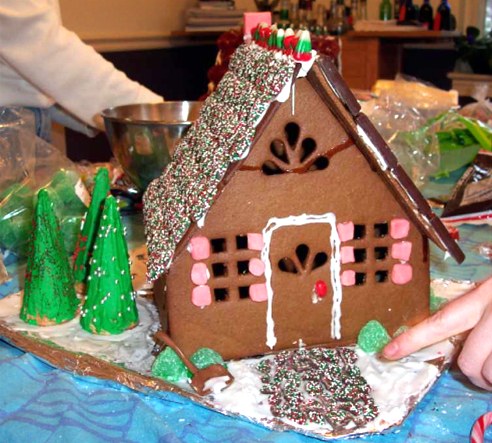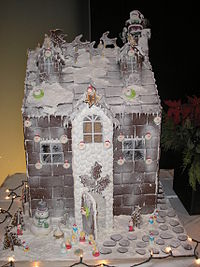History
Gingerbread was brought to Europe in 992 by the Armenian monk Gregory of Nicopolis (Gregory Makar) (Grégoire de Nicopolis). He left Nicopolis Pompeii, to live in Bondaroy (France), near the town of Pithiviers. He stayed there 7 years, and taught the Gingerbread cooking to French priests and Christians. He died in 999.[1][2][3]
During the 13th century, it was brought to Sweden by German immigrants. Early references from the Vadstena monastery show how the Swedish nuns were baking gingerbread to ease indigestion in the year 1444.[4] It was the custom to bake white biscuits and paint them as window decorations. The first documented trade of gingerbread biscuits dates to the 16th century, where they were sold in monasteries, pharmacies and town square farmers' markets. One hundred years later the town of Market Drayton in Shropshire, UK became known for its gingerbread, as is proudly decreed on their town's welcome sign. The first recorded mention of gingerbread being baked in the town dates back to 1793; however, it was probably made earlier, as ginger was stocked in high street businesses from the 1640s. Gingerbread became widely available in the 18th century.
Varieties
Akin to the original middle eastern recipes, English gingerbread is a dense, treacly (molasses-based) spice cake or bread. Some recipes add mustard, pepper, raisins, nuts, apple, and/or other spices/ingredients to the batter. The usual way of making it is to melt the fat and then mix all the ingredients in a bowl (called "the gingerbread method") rather than using rubbing in or creaming to get the fat absorbed into the flour, and this makes it a particularly easy kind of cake to make. It is usually baked in a loaf or square shape, rather than in the round form common for fruit cakes or sponges. It is traditionally eaten on Bonfire Night. As a dessert, the bread usually omits raisins or nuts and is often served with warm lemon sauce. In the United States, this form of gingerbread is sometimes called "gingerbread cake" to distinguish it from the harder forms; as in England it is typically served in winter, but it is particularly associated with Christmas. French pain d'épices is somewhat similar, though generally slightly drier, and always involves honey rather than treacle (and originally its recipe did not involve ginger).Parkin is a form of hard gingerbread made with oatmeal and treacle which is popular in the North of England.
In Germany gingerbread is made in two forms: a soft form called Lebkuchen and a harder form, particularly associated with carnivals and street markets such as the Christmas markets that occur in many German towns. The hard gingerbread is made in decorative shapes, which are then further decorated with sweets and icing. The tradition of cutting gingerbread into shapes takes many other forms, and exists in many countries, a well known example being the gingerbread man. Traditionally, these were dunked in port wine.
In parts of Scandinavia, the most popular form of ginger confection are the pepperkaker (Norwegian), pepparkakor (Swedish) or brunkager (Danish). They are thin, very brittle biscuits that are particularly associated with the extended Christmas period. In Norway and Sweden, pepperkaker/pepparkakor are also used as window decorations, the pepperkaker/pepparkakor are then a little thicker than usual and decorated with glaze and candy. Many families bake pepperkaker/pepparkakor/brunkager as a tradition with their kids. In English, pepperkaker/pepparkakor/brunkager would be referred to as ginger biscuits rather than gingerbread.
Gingerbreads are known in Russia. The most famous gingerbreads there are baked in the ancient cities Tula (Tula gingerbread), Vyazma, and Gorodets.
In Poland, the gingerbreads are knows as Pierniki. The most famous one is known as Toruń gingerbread (Toruński Piernik). Toruński Piernik is a traditional Polish gingerbread that has been produced since the Middle Ages in the city of Toruń (Thorn).
In Croatia, gingerbread known as licitar is traditionally made in the shape of a heart and is used as an ornamental gift
Gingerbread houses and decorations
The harder German-style Gingerbread is often used to build gingerbread houses similar to the "witch's house" encountered by Hansel and Gretel. These houses, covered with a variety of candies and icing, are popular Christmas decorations,[5] often built by chilcity"), it is claimed to be the world's largest such city. It's free for every child under the age of 12 to make their own house with the help of their parents. In 2009, the city was completely destroyed in an act of vandalism, devastating Bergen.[6][7]molded like clay to form inedible statuettes or other decorations. Medieval bakers used carved boards to create elaborate designs.[5]Europe,[] major centers of gingerbread mould carvings included citation neededLyon, Nürnberg, Pest, Prague, Pardubice, Pulsnitz, Ulm, and Toruń. Gingerbread moulds often displayed the "news", showing carved portraits of new kings, emperors, and queens, for example.[] Substantial mould collections are held at the Ethnographic Museum in citation neededToruń, Poland and the Bread Museum in Ulm, Germany
Another variant uses a boiled dough that can be
A significant form of popular art in
Gingerbread is avery delicious food. And a very festive food also for the winter season. It can also be a decorative food as in the form of a gingerbread house.



No comments:
Post a Comment